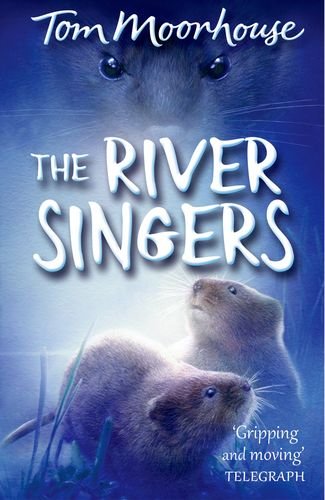Title: The River Singers
Author: Tom Moorhouse
Publisher: Oxford University PRess
Published: July 2014 (PB)
The River Singers by Tom Moorhouse was published in paperback this month, and I thought a review was in order to celebrate since I really, really love this book.
The River Singers is not only a poignant, perfect summer read, but a novel to treasure and keep. I had heard a lot about the story prior to reading it, and reading so much positive press about something means that sometimes you wonder if a novel can really be as incredible as its hype, but The River Singers truly is. Written by Oxford ecologist Tom Moorhouse (who obviously knows his material very well), The River Singers is about a family of water voles who lose their mother and are struggling for survival. Sylvan and his siblings find themselves orphaned when a new, mysterious predator arrives in their home, and soon Sylvan, Fern, Aven and Orris are embarking on a journey to find a new and safe place to live.
This is a beautiful, bewitching story that had me gripped until the last page. Lauren St. John described it as “a hymn to nature, written with compassion and flair”, and the prose certainly has a lilting, lyrical quality at times, delicately painting vivid scenery and minute details of the riverbank world. Still, there are also hypnotic, urgent and gripping depictions of action and danger, and incredible moments of suspense in The River Singers. It is poignant, heartrending and hopeful, ranking with those classic animal tales like The Wind in the Willows, The Animals of Farthing Wood or anything from the likes of Michael Morpurgo, Gill Lewis or Lucy Daniels, books that line children’s bedroom bookcases and deservedly stay there. Something that sets apart The River Singers, though, is the level of immersion and insight we readers have into Sylvan’s world, and the danger that we as readers are forced to feel and live with him, Aven, Orris and Fern, after their home is destroyed by the arrival of a predator. The riverbank universe becomes ours, too, and the threat of the dark, elusive mink (comparatively huge compared to water voles) becomes as real and frightening for us as for the siblings who try desperately to evade it. As animal protagonists go, Sylvan is likeable, compelling, bold and fiercely loyal, and he and his siblings grow as they learn from one another, as well as how to help one another. For these reasons, The River Singers is also a very human story; it is about coping with grief and loss, reeling in the aftermath of trauma, and it reminds us of the importance of sibling loyalty and friendship, more than ever during times of pain, crisis and trouble.
The River Singers is not only a poignant, perfect summer read, but a novel to treasure and keep. I had heard a lot about the story prior to reading it, and reading so much positive press about something means that sometimes you wonder if a novel can really be as incredible as its hype, but The River Singers truly is. Written by Oxford ecologist Tom Moorhouse (who obviously knows his material very well), The River Singers is about a family of water voles who lose their mother and are struggling for survival. Sylvan and his siblings find themselves orphaned when a new, mysterious predator arrives in their home, and soon Sylvan, Fern, Aven and Orris are embarking on a journey to find a new and safe place to live.
This is a beautiful, bewitching story that had me gripped until the last page. Lauren St. John described it as “a hymn to nature, written with compassion and flair”, and the prose certainly has a lilting, lyrical quality at times, delicately painting vivid scenery and minute details of the riverbank world. Still, there are also hypnotic, urgent and gripping depictions of action and danger, and incredible moments of suspense in The River Singers. It is poignant, heartrending and hopeful, ranking with those classic animal tales like The Wind in the Willows, The Animals of Farthing Wood or anything from the likes of Michael Morpurgo, Gill Lewis or Lucy Daniels, books that line children’s bedroom bookcases and deservedly stay there. Something that sets apart The River Singers, though, is the level of immersion and insight we readers have into Sylvan’s world, and the danger that we as readers are forced to feel and live with him, Aven, Orris and Fern, after their home is destroyed by the arrival of a predator. The riverbank universe becomes ours, too, and the threat of the dark, elusive mink (comparatively huge compared to water voles) becomes as real and frightening for us as for the siblings who try desperately to evade it. As animal protagonists go, Sylvan is likeable, compelling, bold and fiercely loyal, and he and his siblings grow as they learn from one another, as well as how to help one another. For these reasons, The River Singers is also a very human story; it is about coping with grief and loss, reeling in the aftermath of trauma, and it reminds us of the importance of sibling loyalty and friendship, more than ever during times of pain, crisis and trouble.
All in all, I really cannot recommend The River Singers enough. As I have been blogging about libraries a little this week, it seemed another good reason to review The River Singers, since this – as an incredible Middle Grade read, ideal for children aged nine and older – definitely has a place in both primary and secondary school libraries. It is a perfect story to read aloud with older primary children, either one-to-one or as a class read. A sequel, The Rising, is due out in October this year (link here), and I will certainly be buying it.


